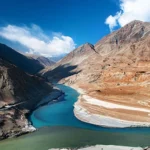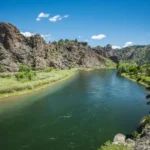
The Caspian Sea is the world’s largest enclosed inland body of water, covering about 371,000 square kilometers. It is bordered by five countries: Russia, Iran, Kazakhstan, Turkmenistan, and Azerbaijan. Its unique geographical location has played a significant part in shaping the history and culture of the region. Throughout centuries, the Caspian Sea has served as a vital trade route, fostering cultural and commercial exchanges between Europe and Asia.
With a maximum depth of approximately 1,025 meters, the Caspian Sea stands as one of the deepest lakes in the world. Its impressive depth is attributed to the tectonic activity in the region. This immense water depth, coupled with the sea’s vast surface area, ensures the preservation of diverse marine ecosystems and contributes to its distinction as a globally important biodiversity hotspot.
The name “Caspian” is believed to have derived from the ancient Caspi tribe, who once inhabited the region. The sea has been referred to by different names throughout history, such as the “Khazar Sea” during the Khazar Empire and the “Hyrcanian Sea” in ancient Greek and Persian texts. The name “Caspian Sea” became widely recognized in the West during the medieval period.
The Caspian Sea shorelines are home to several iconic port cities with rich historical significance. One such example is Baku, located in Azerbaijan, which has served as a prominent hub for trade and cultural exchange for centuries. Baku has a history dating back at least to the 1st century AD, and its cultural heritage is reflected in the UNESCO-listed Old City and its architectural marvels.
The Caspian Sea is renowned for its abundant oil and gas reserves. It is estimated that the sea holds nearly 50 billion barrels of oil and over 8 trillion cubic meters of natural gas in proven reserves. These energy resources have significantly impacted regional economies and have made the Caspian Sea an important player in global energy markets.
The Caspian Sea carries historical and cultural significance, as it has been part of various empires throughout history. It was a critical territory for the Mongol Empire, the Persian Empire, and the Russian Empire, among others. The Caspian Sea’s strategic location, as a gateway between Asia and Europe, made it a coveted area for control and dominance.
The Caspian Sea acts as a habitat for various species of fish and marine life, including sturgeons. Sturgeon fishing in the Caspian Sea has a long history and has been valued for its highly prized caviar. However, overfishing and environmental challenges have led to a decline in sturgeon populations, highlighting the need for conservation efforts to protect these endangered species.
The Caspian Sea has experienced significant environmental changes over time, including fluctuations in water levels. In recent years, the sea’s water level has been gradually rising due to factors such as climate change and increased river flow. This rise has caused concerns about coastal erosion and the potential flooding of low-lying areas along the shore.
The legal status of the Caspian Sea has been a matter of international debate among the five countries bordering the sea. It wasn’t until August 2018 that the Convention on the Legal Status of the Caspian Sea was signed, establishing guidelines for the use and management of the sea’s resources. This landmark agreement has set the stage for increased cooperation and coordination among the Caspian littoral states.
The Caspian Sea has cultural and historical ties to various ancient civilizations. The ancient Greeks and Persians considered the Caspian Sea as a significant geographical feature and mentioned it in their historical and literary works. Furthermore, archaeological excavations in the region have yielded artifacts dating back thousands of years, providing insights into the early human settlements along its shores.
The Caspian Sea’s unique ecosystem not only includes marine life but also features the presence of the Caspian seal (Pusa caspica), one of the only freshwater seal species in the world. These seals have adapted to the brackish waters of the Caspian Sea and are considered critically endangered. Their decline in population has raised concerns among environmentalists and conservationists, prompting efforts to protect their habitat and preserve their existence.
The city of Aktau, located on the eastern shore of the Caspian Sea in Kazakhstan, serves as a vital port and industrial center for the region. It has strategic significance in supporting the oil and gas industry, trade, and transportation activities. Aktau acts as a gateway between Central Asia and the Caucasus, contributing to regional connectivity and economic development.
The Caspian Sea has witnessed significant geological activity throughout history. It is home to numerous mud volcanoes, natural gas vents, and seismic fault lines. The volcanic activity releases gases and minerals, creating unique geological formations and landscapes. The mud volcanoes in the area provide a natural laboratory for studying geology and contribute to the Caspian Sea’s distinct character.
The region surrounding the Caspian Sea has a rich and diverse cultural heritage, with communities representing various ethnic groups and traditions. Kazakhs, Azerbaijanis, Russians, Persians, and Turkmen are among the major ethnic groups found in the Caspian Sea basin. Each community has contributed to the cultural tapestry of the region, showcasing their languages, customs, cuisines, and traditional arts.
The Caspian Sea’s oil and gas reserves have attracted significant exploration and production activities. The sea’s basin holds numerous oil and gas fields, with the largest being the Kashagan Field discovered in 2000. The Kashagan Field, located off the coast of Kazakhstan, is estimated to hold substantial oil reserves and has been subject to extensive international collaboration for its development.
Astrakhan, a historic city in Russia located along the Caspian Sea, played a crucial role in Russian trade and diplomacy. As a prominent center for commerce and cultural exchange between Europe and Asia, Astrakhan facilitated connections between the Russian Empire and various Silk Road routes. The city’s significance continues to this day, acting as a bridge between different cultures and economies.
The Caspian Sea has been a subject of scientific research and exploration. Numerous scientific expeditions have ventured into the region to study its unique ecosystem, geology, and environmental changes. Researchers focus on diverse fields, including marine biology, geophysics, oceanography, and climate science, contributing to our understanding of the sea’s complex dynamics and preservation.
The port city of Bandar-e Anzali in Iran has historical importance as a major commercial and fishing hub on the Caspian Sea. It has served as a base for Iran’s navy, facilitating maritime operations and safeguarding national interests. The city’s maritime heritage, combined with its picturesque location, attracts tourists interested in exploring Iranian culture, local cuisine, and the scenic beauty of the Caspian Sea coastline.
The Caspian Sea’s water levels have experienced fluctuations throughout history. In recent years, climate change and increased river flow from the Volga River have contributed to rising water levels. The fluctuation affects coastal communities, wildlife habitats, and infrastructure along the shoreline. The changing water levels prompt adaptive measures for coastal management and engineering.
The Caspian Sea has long been a cradle of civilization, with evidence of human habitation spanning thousands of years. Archaeological discoveries in the region have provided insights into ancient civilizations, such as the ancient Scythians, who left behind burial mounds (kurgans) containing fascinating artifacts and cultural remnants. Archaeological expeditions continue to unearth the secrets of the Caspian Sea’s rich historical past.
Caspian terns, a bird species found in the Caspian Sea region, hold the record for the longest bird migration. They travel from their breeding grounds in the Caspian Sea to their wintering grounds in southern Africa, covering a distance of approximately 20,000 kilometers (12,427 miles). This impressive migration demonstrates the diverse terrestrial and marine ecosystems that the Caspian Sea supports.
The Caspian Sea has been a center of international diplomacy and cooperation. The five bordering countries have engaged in discussions and negotiations to resolve disputes, establish environmental regulations, and enhance regional cooperation. The Convention on the Legal Status of the Caspian Sea, signed in 2018, represents a cooperative framework that allows the littoral states to address shared concerns and promote sustainable development.
The Caspian Sea has served as inspiration for various artists and writers throughout history. Prominent Russian poet Alexander Pushkin mentioned the Caspian Sea in his works, highlighting its vastness and importance in Russian literature. The sea’s captivating beauty and cultural significance have been captured in paintings, literature, and musical compositions, establishing it as a muse for creative expression.
Gobustan National Park, located in Azerbaijan along the Caspian Sea, is home to ancient rock art and archaeological sites. The park showcases more than 6,000 rock engravings, reflecting the artistic and cultural heritage of early human civilizations in the region. These engravings provide valuable insights into prehistoric life, rituals, and the natural environment of the Caspian Sea area.
The Avaza resort area in Turkmenistan offers a unique Caspian Sea tourism experience. It features luxurious hotels, entertainment venues, and recreational facilities. With its sandy beaches and warm climate, the area attracts tourists seeking relaxation, water sports, and a taste of Turkmen hospitality. Avaza aims to promote tourism and economic development in the region, expanding the Caspian Sea’s appeal as a leisure destination.








